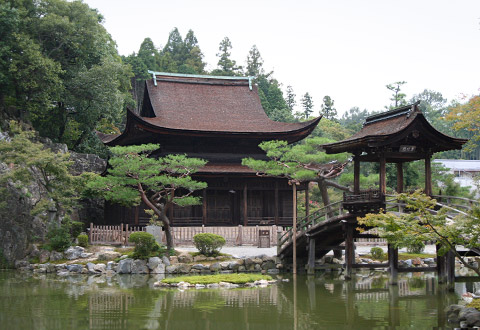|
||
 |
||

Eihouji
Kannondou 永保寺観音堂 (Gifu)
(C)2001 Japanese Architecture and Art Net Users System. No reproduction or republication without written permission.
掲載のテキスト・写真・イラストなど、全てのコンテンツの無断複製・転載を禁じます。
|
||||||
| kannondou 観音堂 | ||||||
| KEY WORD : architecture / buildings & structures | ||||||
| A Buddhist
temple hall dedicated to the Goddess of Mercy *Kannon
観音. Fukushima prefecture has six Kannondou, Chiba prefecture has three,
and about fourteen other prefectures each have one. Among more than twenty
extant halls, two are National Treasures: Eihouji 永保寺 Kannondou (1314)
in Gifu prefecture and Kouonji 孝恩寺 Kannondou (late Kamakura period)
in Osaka. Many others are designated important cultural properties. There
is no strict uniformity of size or style. However, the majority are 3 x
3 bays square, but the actual dimensions vary from 4.72m to 7.90m. Kouonji
Kannondou is a large square 5 x 5 bay (12.72m) structure; Wakamatsudera
若松寺 Kannondou (1509) in Yamagata prefecture is also 5 x 5 bays but
is not quite square, being 12.73 x 12.12. Other 5 x 5 bay Kannondou
are slightly smaller. Bandaiji 磐台寺 Kannondou (1570-73) in Hiroshima
prefecture is the smallest hall at 3 x 3 bays. It is a rectangle and measures
3.11m x 5.18m. The largest is the Byoudouin 平等院 Kannondou (early Kamakura
period) in Kyoto. Most have hipped roofs *yosemune-zukuri
寄棟造, eight have hip-and-gable roofs *irimoya-zukuri
入母屋造, and only two of the Kannondou listed as important cultural
properties have pyramidal roofs *hougyou-zukuri
宝形造. Roofing materials in order of frequency are: thatch *kayabuki
茅葺, copper sheeting, doubanbuki 銅板葺, and tile roofing *hongawara-buki
本瓦葺; two have cypress bark roofing *hiwadabuki
桧皮葺; and one has thin, thickly layered shingles, *kokerabuki
柿葺. Halls with copper roof sheeting were originally thatch. Most halls have
closely spaced rafters *shigedaruki
繁垂木, and double eaves *futanoki
二軒, while a few have widely spaced rafters *mabaradaruki
疎垂木, and single eaves *hitonoki
一軒. Zen style *zenshuuyou
禅宗様, characteristics are found in many Kannondou for example, Eihouji
Kannondou, Toushunji 洞春寺 Kannondou (1430) in Yamaguchi prefecture
and Shinkoumyouji 信光明寺 Kannondou (1478) in Aichi prefecture. Kouonji
Kannondou is clearly wayou style *wayou
和様 on the exterior but has a smooth board ceiling *kagamitenjou
鏡天井, and other Zen characteristics in small details on the interior. The
use of fan rafters *ougidaruki
扇垂木, that radiate toward the corners instead of being set parallel, are
also identified with the Zen style. Kannondou with fan rafters include:
Kousouji 高倉寺 (14c) in Saitama prefecture, Shinkoumyouji, Shouunji 祥雲寺
(1431), in Ehime prefecture; and Houraiji 鳳来寺 (1803) in Chiba prefecture.
Bracket complexes *tokyou
斗きょう, vary from building to building. The majority are the 3-on-1, non-projecting
type *hiramitsudo
平三斗. Simple boat-shaped brackets *funahijiki
舟肘木, and 3-on-1 at right angles *demitsudo
出三斗, are numerous. One-stepped bracket complexes *degumi
出組, are rare, and only two buildings have a large bearing blocks with a
bracket arm *daito hijiki
大斗肘木, although they appear on the enclosed pent roof *mokoshi
裳階, of one building. In Kannondou with distinctive Zen style elements, a
few have two-stepped bracket complexes *futatesakigumi
二手先組. Most buildings have plank floors but Shouunji Kannondou. Toushunji
Kannondou, Shinkoumyouji Kannondou and Jourokuji 丈六寺 Kannondou
(1648) in Tokushima prefecture, have hard-packed earthen floors covered
with stone *ishijiki
石敷, or tiles *kawara 瓦.
|
||||||
 Eihouji
Kannondou 永保寺観音堂 (Gifu)
|
||||||
| REFERENCES: | ||||||
| EXTERNAL LINKS: | ||||||
| NOTES: | ||||||
(C)2001 Japanese Architecture and Art Net Users System. No reproduction or republication without written permission. 掲載のテキスト・写真・イラストなど、全てのコンテンツの無断複製・転載を禁じます。 |
||||||